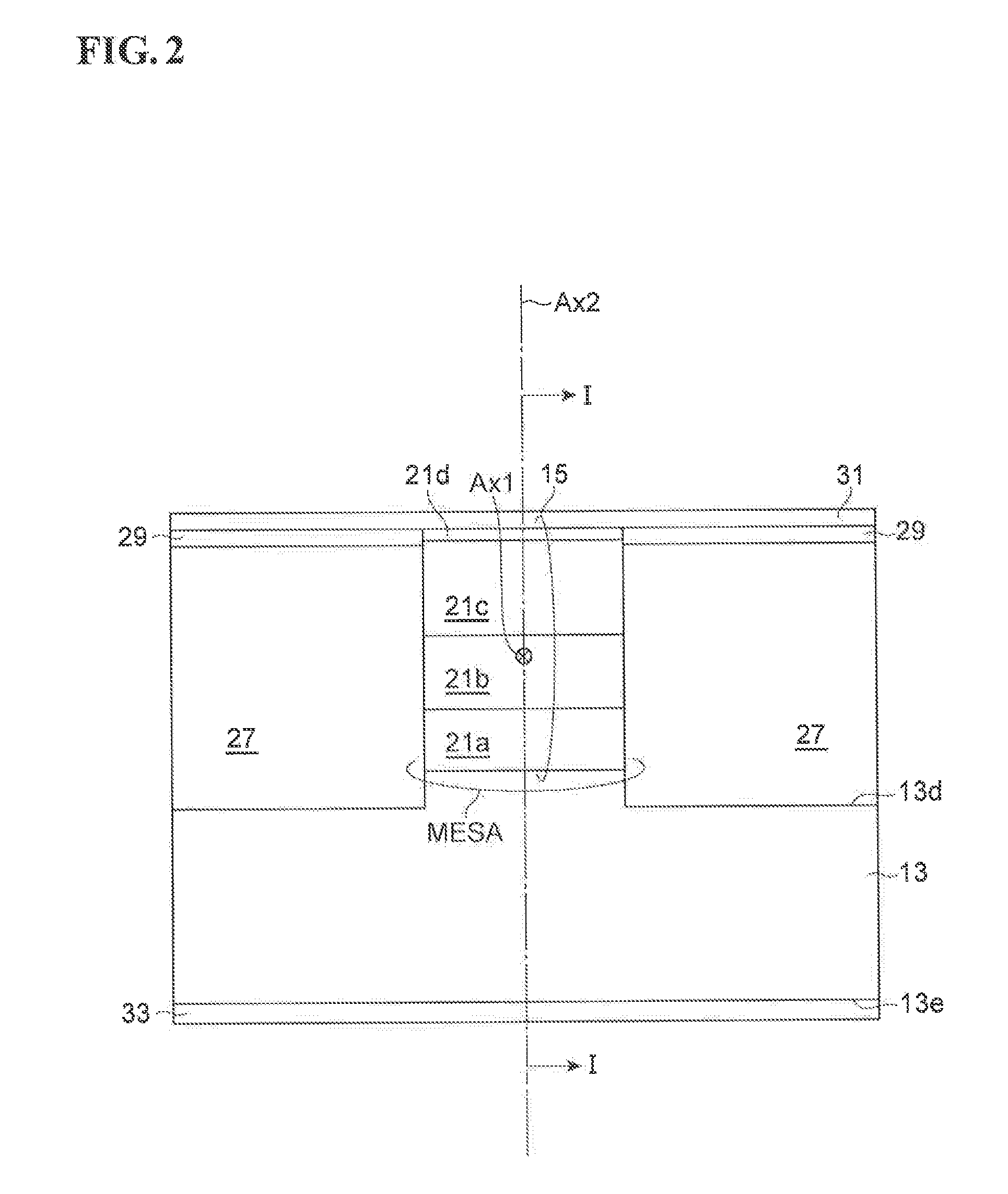Quantum cascade laser
a laser and quantum cascade technology, applied in the direction of laser details, semiconductor lasers, electrical devices, etc., can solve the problems of decreasing production yield and durability (mechanical strength), and achieve the effects of increasing etching depth, increasing production yield and durability (mechanical strength), and relatively large thickness of stacked semiconductor layers
- Summary
- Abstract
- Description
- Claims
- Application Information
AI Technical Summary
Benefits of technology
Problems solved by technology
Method used
Image
Examples
first embodiment
[0053]FIG. 1 schematically illustrates a quantum cascade laser (QCL) according to this embodiment. FIG. 1 illustrates a quantum cascade laser 11 including a distributed Bragg reflection structure. FIG. 1 is a sectional view taken in a direction in which an optical waveguide of the quantum cascade laser 11 extends. The quantum cascade laser 11 includes a substrate 13, a stacked semiconductor layer 15, a distributed Bragg reflection structure 17, and another distributed Bragg reflection structure 19. The substrate 13 includes a first region 13a, a second region 13b, and a third region 13c. The first region 13a, the second region 13b, and the third region 13c are arranged along a first axis Ax1 that indicates a direction in which the optical waveguide of the quantum cascade laser 11 extends. The substrate 13 has a principal surface 13d and a back surface 13e. Thus, each of the first region 13a, the second region 13b, and the third region 13c also has the principal surface 13d and the b...
second embodiment
[0105]A method for producing a quantum cascade laser will be described with reference to FIG. 4A to FIG. 12D. In FIG. 4A to FIG. 12D, FIGS. 4A, 5A, 6A, 7A, 8A, 9A, 10A, 11A, and 12A are sectional views in a stacked semiconductor layer to be a laser main body, the sectional views being taken along a line (for example, in FIG. 4A, line IVa-IVa of FIG. 4C) perpendicular to a direction in which an optical waveguide extends. FIGS. 4B, 5B, 6B, 7B, 8B, 9B, 10B, 11B, and 12B are sectional views in a semiconductor wall of a distributed Bragg reflection structure, the sectional views being taken along a line (for example, in FIG. 4B, line IVb-IVb of FIG. 4C) perpendicular to a direction in which an optical waveguide extends. FIGS. 4C, 5C, 6C, 7C, 8C, 9C, 10C, 11C, and 12C are sectional views illustrating an optical waveguide, the sectional views being taken along a line (for example, in FIG. 4C, line IVc-IVc of FIG. 4A) that extends in a direction in which the optical waveguide extends. FIGS....
third embodiment
[0116]FIG. 13 illustrates a quantum cascade laser 11a. The quantum cascade laser 11a includes a distributed Bragg reflection structure 81 (83) instead of the distributed Bragg reflection structure 17 (19) of the quantum cascade laser 11. The distributed Bragg reflection structure 81 (83) includes one or more semiconductor walls 81b (83b) that are arranged away from the end facet 15a (15b) of the stacked semiconductor layer 15. The end facet 15a (15b) of the stacked semiconductor layer 15 and the semiconductor walls 81b (83b) are arranged along the first axis Ax1 to constitute the distributed Bragg reflection structure 81 (83). The distance D3 between the upper ends of the semiconductor walls 81b (83b) and the back surface of the substrate 13 is larger than the distance D2 between the upper surface of the stacked semiconductor layer 15 and the back surface of the substrate 13. The semiconductor walls 81b (83b) are extended in the Ax2 direction with a predetermined distance so that li...
PUM
 Login to View More
Login to View More Abstract
Description
Claims
Application Information
 Login to View More
Login to View More - R&D
- Intellectual Property
- Life Sciences
- Materials
- Tech Scout
- Unparalleled Data Quality
- Higher Quality Content
- 60% Fewer Hallucinations
Browse by: Latest US Patents, China's latest patents, Technical Efficacy Thesaurus, Application Domain, Technology Topic, Popular Technical Reports.
© 2025 PatSnap. All rights reserved.Legal|Privacy policy|Modern Slavery Act Transparency Statement|Sitemap|About US| Contact US: help@patsnap.com



